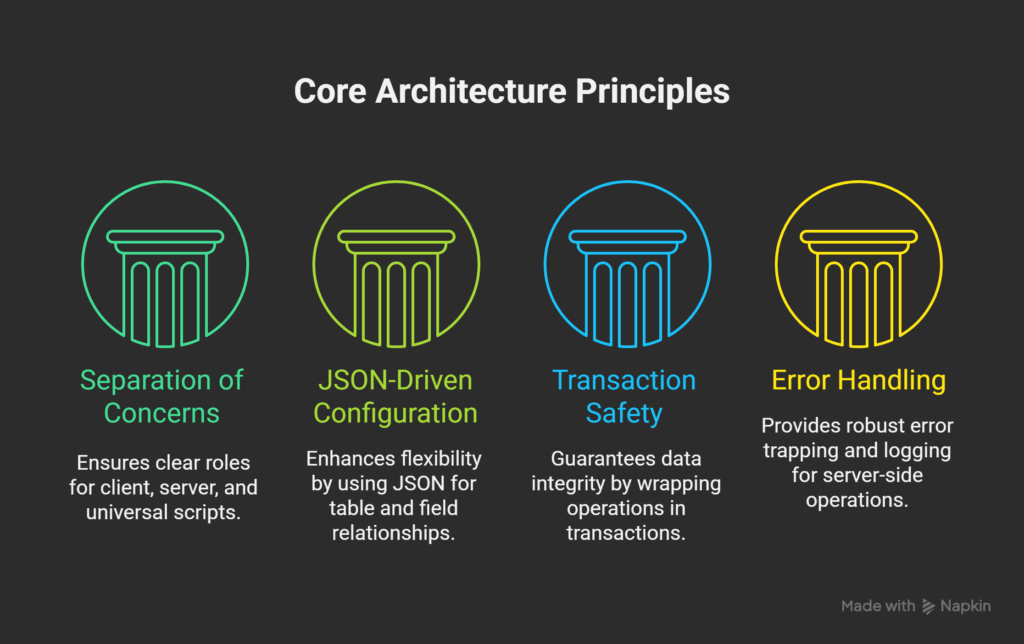Stuart Gripman, FileMaker DevCon 2017
Introduction
In the realm of software development, particularly within the FileMaker community, technical prowess is indispensable. However, as highlighted in the 2017 FileMaker DevCon session titled “Cultivating Project Champions and Coping with Detractors“, technical skills are only half the battle. The other half involves understanding and managing the personalities and office politics that can significantly influence the success of a project.
This session, presented by Stuart Gripman of DriveSavers Data Recovery on November 10, 2017, delved into the nuances of human interaction within project environments. The core message was clear: development projects are fundamentally about people. Regardless of the industry, technology, scope, or goal, your ability to read and manage personalities has a profound impact on project outcomes.
This comprehensive guide expands upon the insights shared during that session, providing you with detailed strategies to identify allies, foster positive collaboration, and effectively cope with those who may threaten to derail your project through ignorance, apathy, or ill will.
Menu
- Introduction
- Ground Rules
- The Critical Role of Office Politics
- Decoding the Personality Matrix
- Perceiving Personalities and Roles
- Cultivating Your Champions
- Managing Detractors
- Dealing with Saboteurs
- When Things Go Off the Rails
- Summary
- Final Thoughts
- Further Resources
Ground Rules #tag1
Before delving into strategies for managing personalities and navigating office politics, it’s essential to establish foundational principles that will guide your approach throughout any project.
Ethical Influence Over Manipulation
Avoid Being Machiavellian: The name Machiavelli often conjures images of manipulation and control. However, our goal isn’t to manipulate others for personal gain but to ethically influence stakeholders to achieve mutually beneficial outcomes.
Positive Intentions: Your efforts should stem from a genuine desire to see the project succeed for the benefit of all involved, not just to showcase your technical skills or advance your personal agenda.
Prioritize Client and Project Success
Client-Centric Focus: As emphasized in Mahan Khalsa’s book “Let’s Get Real or Let’s Not Play”, the best outcomes arise when you prioritize the client’s needs and success over your own.
Mutual Benefits: When you help your clients achieve their goals, you not only fulfill your obligations but also build a strong reputation, leading to repeat business and referrals.
Embrace the Human Element
People Are Central: Remember the wisdom shared by seasoned professionals: “I don’t care what you’re doing; it always involves people.” Technology is merely a tool; it’s the people behind it who drive success.
Develop Interpersonal Skills: Cultivating your ability to read and manage personalities is as crucial as enhancing your technical abilities.
The Critical Role of Office Politics #tag2
Office politics is an inescapable aspect of professional life. Ignoring it can be detrimental to both your project and your career. Understanding the political landscape allows you to navigate challenges effectively and leverage opportunities.
Scapegoating Risks
Convenient Targets: Developers, especially external consultants, are often the first to be blamed when projects encounter issues, regardless of the root cause.
Protecting Your Reputation: By being aware of office politics, you can take proactive steps to mitigate risks and avoid becoming a scapegoat.
Lost Opportunities Due to Ignorance
Missing Subtle Cues: Failing to recognize the influence of key individuals can result in lost contracts and damaged relationships.
Example: In a past project with LeapFrog, overlooking a colleague’s advice to consult with an influential person led to a short-lived contract, demonstrating the consequences of ignoring office politics.
Enhancing Project Success
Identifying Supporters and Opponents: Knowing who supports your project and who may be working against it enables you to strategize accordingly.
Building Alliances: Cultivating relationships with influential stakeholders can propel your project forward and help overcome obstacles.
The LeapFrog Experience Revisited
Working with LeapFrog in the 1990s provided a valuable lesson. During initial meetings, a colleague suggested consulting with a key individual, Dick Swearingen. Ignoring this advice due to a desire to stay out of internal politics led to the project’s failure and the loss of a significant opportunity.
Key Takeaway: Always pay attention to the internal dynamics of the organizations you work with, even as an external consultant. Understanding and engaging with office politics is essential for project success.
Decoding the Personality Matrix #tag3
Understanding the different personalities within a project environment is crucial for effective management and collaboration. Below is a comprehensive matrix outlining common personality types, their characteristics, potential impact on your project, and strategies for engagement.
Overview of the Matrix
- Vertical Axis: Represents the level of interaction required. The higher the position, the more hands-on management is necessary.
- Horizontal Axis: Indicates potential impact on the project. Left denotes negative impact, while right signifies positive influence.
Begrudging Worker #tag4
Characteristics:
- Resistant to change but compliant out of obligation.
- May exhibit apathy or mild resentment towards the project.
- Typically lacks influence within the organization.
Impact:
- Low Risk: Unlikely to actively sabotage the project but may contribute minimally.
- Passive Resistance: Their lack of enthusiasm can affect team morale subtly.
Strategy:
- Maintain Professionalism: Treat them courteously without expecting proactive engagement.
- Provide Clear Guidance: Ensure instructions are straightforward to facilitate compliance.
Invested Worker #tag5
Characteristics:
- Sees the project’s benefits and is enthusiastic about contributing.
- Willing to go beyond their duties to support the project.
- Often serves as a positive influence among peers.
Impact:
- Highly Positive: Can significantly enhance project efficiency through active participation.
- Peer Motivation: May encourage other team members to become more involved.
Strategy:
- Engage Actively: Involve them in decision-making and testing phases.
- Recognize Contributions: Acknowledge their efforts to reinforce their commitment.
Detractor #tag6
Characteristics:
- Openly expresses opposition to the project.
- Rarely offers constructive feedback, focusing on negatives.
- May be influenced by past experiences or fear of change.
Impact:
- Potentially Harmful: Can influence others negatively and impede progress.
- Creates Obstacles: May slow down processes through persistent criticism.
Strategy:
- Listen Actively: Allow them to voice concerns fully to understand underlying issues.
- Address Valid Points: Identify legitimate concerns and work towards solutions.
- Limit Influence: Prevent their negativity from spreading by fostering a positive team environment.
The Seer #tag7
Characteristics:
- Possesses visionary insights, seeing long-term project implications.
- Highly enthusiastic and often suggests innovative ideas.
- May inadvertently push for scope expansion.
Impact:
- Positively Transformative: Can contribute groundbreaking ideas that enhance the project.
- Risk of Overreach: May lead to scope creep if not managed carefully.
Strategy:
- Encourage Vision: Value their creativity and insights.
- Set Clear Boundaries: Define project scope explicitly to manage expectations.
- Plan for Future Phases: Document their ideas for potential inclusion in future project iterations.
The Manager #tag8
Characteristics:
- Supervises team members and influences resource allocation.
- Their support or opposition can significantly affect project dynamics.
- May have their own objectives that align or conflict with the project.
Impact:
- Variable Influence: Can either facilitate smooth project execution or create obstacles.
- Team Morale: Their attitude towards the project affects team engagement.
Strategy:
- Assess Alignment: Determine whether their goals align with the project’s objectives.
- Collaborate Effectively: Build a cooperative relationship if supportive.
- Negotiate Differences: Find common ground if initial resistance is present.
The Money #tag9
Characteristics:
- Manages financial aspects, including budgets and payments.
- Often has a broad understanding of organizational operations.
- May not be directly involved in project execution.
Impact:
- Critical for Contractors: Influences payment schedules and financial approvals.
- Organizational Insight: Can provide valuable information about internal processes and politics.
Strategy:
- Build Rapport: Establish a positive relationship for smoother financial transactions.
- Leverage Insights: Discreetly seek information about organizational dynamics.
The Project Champion #tag10
Characteristics:
- Advocates strongly for the project’s success within the organization.
- Willing to invest personal credibility and political capital.
- Holds significant influence and can mobilize resources.
Impact:
- Essential for Success: Their support can overcome substantial obstacles.
- Resource Mobilization: Can facilitate access to necessary resources and approvals.
Strategy:
- Close Partnership: Engage them regularly and keep them informed.
- Empower Their Advocacy: Provide them with the tools and information they need to champion the project.
- Express Appreciation: Acknowledge their efforts to reinforce the partnership.
The Saboteur #tag11
Characteristics:
- Actively works to undermine the project.
- May sabotage through misinformation, obstruction, or manipulation.
- Motivated by personal agendas, such as job security or power struggles.
Impact:
- Highly Detrimental: Can cause project delays, increased costs, or complete failure.
- Team Disruption: Negatively affects team cohesion and morale.
Strategy:
- Early Detection: Be vigilant for signs of sabotage.
- Avoid Direct Confrontation: Address issues through proper channels.
- Involve Leadership: Escalate concerns to higher authorities discreetly.
Perceiving Personalities and Roles #tag12
Identifying and understanding the various personalities within your project environment requires keen observation and active engagement. This awareness enables you to tailor your interactions effectively and navigate complex dynamics.
Active Listening #tag13
The Power of Silence:
- Reduce Talking: Prioritize listening over speaking to absorb more information.
- Engage Fully: Focus on the speaker without formulating your response prematurely.
Techniques:
- Ask Probing Questions: Encourage deeper discussion and demonstrate interest.
- Reflect and Paraphrase: Restate their points to confirm understanding and show attentiveness.
Benefits:
- Builds Trust: Validates the speaker’s perspective, fostering mutual respect.
- Gathers Insights: Uncovers underlying motivations, concerns, and expectations.
Observing Body Language #tag14
Importance of Non-Verbal Cues:
- Unspoken Communication: Body language often reveals true feelings.
- Relationship Dynamics: Observing interactions can reveal hierarchies and alliances.
Key Observations:
- Gestures and Postures: Open gestures indicate receptivity; closed postures may signal resistance.
- Facial Expressions: Smiles, frowns, and eye contact provide immediate feedback.
- Group Reactions: Notice how others respond to a speaker to gauge influence and credibility.
Practical Tips:
- Look Up Often: Avoid being engrossed in note-taking; observe the room.
- Read the Room: Assess the overall mood and energy during discussions.
Interpreting Tone of Voice #tag15
Elements of Tone:
- Pitch and Volume: High pitch or loud volume can indicate excitement or agitation.
- Speech Rate: Rapid speech may reflect enthusiasm or anxiety; slow speech can suggest deliberation or reluctance.
- Inflection and Emphasis: Variations can highlight importance or reveal uncertainty.
Contextual Understanding:
- Consistency with Words: Ensure the tone matches the content of the message.
- Emotional Indicators: Changes in tone may signal emotional responses needing attention.
Case Study: The Importance of Paying Attention #tag16
Scenario:
In a project meeting, a key participant with a learning disability contributed valuable insights but required more time to articulate thoughts. A subcontractor, eager to demonstrate expertise, frequently interrupted, assuming they knew where the participant was heading.
Consequences:
- Missed Information: Critical insights were lost due to interruptions.
- Damaged Relationships: The participant felt disrespected, leading to potential disengagement.
- Team Friction: The subcontractor’s behavior may have caused discomfort among other team members.
Lessons Learned:
- Patience is Crucial: Allow everyone the time they need to express themselves fully.
- Avoid Assumptions: Even if you think you know what’s coming, listen completely to ensure accuracy.
- Respectful Engagement: Foster an inclusive environment where all contributions are valued.
Cultivating Your Champions #tag17
Building strong relationships with project champions and supportive team members is vital for driving the project forward. Their influence can help navigate obstacles and foster a collaborative environment.
Acts of Kindness #tag18
Significance:
- Reciprocity and Goodwill: Small gestures can lead to increased support and cooperation.
- Personal Connection: Demonstrates appreciation for individuals beyond their professional role.
Examples:
- Implementing Minor Requests: Accommodate small feature requests that enhance their experience.
- Personalized Gestures: Remembering and acknowledging their preferences, such as bringing their favorite snack to a meeting.
Impact:
- Strengthened Relationships: Builds trust and loyalty.
- Enhanced Collaboration: Encourages open communication and willingness to help.
Seeking Advice and Rulings #tag19
Why It Matters:
- Empowers Stakeholders: Involving them in decisions fosters ownership and commitment.
- Leverages Expertise: Benefits from their knowledge and perspective.
How to Engage:
- Present Options Clearly: Outline possible solutions with pros and cons.
- Solicit Input Respectfully: Ask for their guidance on critical decisions.
Benefits:
- Shared Responsibility: Reduces the burden of decision-making and spreads accountability.
- Improved Solutions: Combines technical expertise with organizational insight.
Thoughtful Gift-Giving #tag20
Purpose:
- Expresses Appreciation: Tangible tokens of gratitude can reinforce positive relationships.
- Cultural Respect: Acknowledges traditions and norms where appropriate.
Guidelines:
- Appropriate Value: Keep gifts modest to avoid ethical issues.
- Personalization: Tailor gifts to individual interests for greater impact.
Examples:
- Homemade Treats: Sharing baked goods can brighten meetings and show effort.
- Special Recognition: Commemorate milestones or achievements with a small token.
Ethical Considerations #tag21
Awareness of Policies:
- Company Regulations: Adhere to organizational guidelines regarding gifts and gratuities.
- Legal Restrictions: Be mindful of laws, especially when working with government entities.
Avoiding Misinterpretation:
- Professional Boundaries: Ensure gifts are appropriate and cannot be misconstrued.
- Transparency: When in doubt, disclose gift-giving intentions to supervisors or compliance officers.
Real-Life Example: The Power of Small Gestures #tag22
Scenario:
A developer baked and shared homemade cookies, including personalized fortune cookies, with clients during the holiday season.
Outcome:
- Long-Term Goodwill: Years later, clients fondly remembered the gesture, reinforcing the professional relationship.
- Positive Reputation: Such thoughtful acts contributed to a favorable perception of the developer and their work.
Lesson Learned:
- Lasting Impact: Simple, personalized gestures can create enduring positive effects far beyond the initial effort.
Managing Detractors #tag23
Effectively addressing detractors is essential to prevent them from hindering project progress. Through careful management, you can mitigate their negative impact and potentially turn them into neutral or even supportive participants.
Listening Actively to Detractors #tag24
Importance:
- Uncovering Underlying Issues: They may have valid concerns that need addressing.
- Building Respect: Demonstrates that you value their perspective.
Approach:
- Provide a Platform: Allow them to express their thoughts without interruption.
- Show Empathy: Acknowledge their feelings and concerns genuinely.
Engaging in Constructive Dialogue #tag25
Facilitating Solutions:
- Ask Open-Ended Questions: Encourage them to elaborate and think critically about their concerns.
- Focus on Collaboration: Shift the conversation towards finding mutually acceptable solutions.
Possible Outcomes:
- Revealed Insights: Gain valuable information that can improve the project.
- Reduced Opposition: They may become less resistant once they feel heard.
Setting Boundaries #tag26
Managing Time and Focus:
- Set Time Limits: Keep discussions concise to maintain productivity.
- Stay on Topic: Gently steer conversations back to relevant issues.
Maintaining Professionalism:
- Avoid Escalation: Keep emotions in check and respond calmly.
- Assertiveness: Be firm but respectful in addressing unproductive behaviors.
Seeking Support from Champions #tag27
When to Involve Others:
- Persistent Resistance: If detractors continue to hinder progress despite efforts.
- Impact on Team: When their behavior affects overall team morale or efficiency.
How to Proceed:
- Private Consultation: Discuss concerns with your project champion or a supportive manager.
- Develop a Plan: Collaborate on strategies to address the detractor’s behavior.
Benefits:
- Shared Responsibility: Distributes the burden of managing difficult personalities.
- Unified Front: Demonstrates collective commitment to the project’s success.
Avoiding the Pitfall of Rhetoric #tag28
Ineffectiveness of Persuasion Attempts:
- Resistance to Arguments: Detractors are often not swayed by logical arguments or technical explanations.
- Potential Backfire: May reinforce their opposition or create additional friction.
Alternative Approach:
- Demonstrate Results: Let the quality of your work and the benefits of the project speak for themselves.
- Build Credibility: Consistent delivery of promised outcomes can gradually reduce resistance.
Personal Anecdote: Winning Through Action #tag29
Scenario:
A client was skeptical about the recommendation to install a specific faucet model (Kohler K-597), despite assurances of its benefits.
Outcome:
- Exceeded Expectations: After installation, the client found the faucet significantly improved their daily experience.
- Lesson Learned: Direct experience of tangible benefits was more convincing than any verbal persuasion.
Application:
- Focus on Deliverables: Rather than trying to convince detractors through discussion, prioritize delivering high-quality results that address their concerns.
Dealing with Saboteurs #tag30
Saboteurs pose a serious threat to project success. Handling them requires careful strategy to minimize their impact without escalating conflicts.
Identifying a Saboteur #tag31
Warning Signs:
- Consistent Obstruction: Regularly impedes progress without valid reasons.
- Information Withholding: Fails to provide necessary data or resources.
- Negative Influence: Spreads misinformation or fosters dissent among team members.
Observation Tactics:
- Pattern Recognition: Look for repeated behaviors that hinder the project.
- Feedback from Others: Listen to concerns raised by team members about certain individuals.
Non-Confrontational Approach #tag32
Professionalism is Key:
- Avoid Accusations: Do not confront the individual directly with accusations of sabotage.
- Maintain Composure: Interact with the saboteur courteously to prevent escalation.
Documentation:
- Record Incidents: Keep detailed notes of problematic behaviors and their impact.
- Gather Evidence: Collect emails, missed deadlines, and other tangible proof.
Escalating Appropriately #tag33
Involving Leadership:
- Discreet Communication: Bring your concerns to your project champion or manager privately.
- Present Facts Objectively: Focus on how the behaviors affect the project, not personal grievances.
Possible Interventions:
- Mediation: Leadership may arrange for a mediated discussion to resolve issues.
- Reassignment or Removal: The saboteur may be reassigned or removed from the project if necessary.
Protecting the Project:
- Leadership Support: Having higher-ups involved adds authority to address the issue.
- Minimizing Disruption: Allows for a structured approach to mitigate the saboteur’s impact.
Case Study: A Project Undermined #tag34
Scenario:
A developer was hired to create a system to streamline data aggregation for a government agency. A contractor responsible for manually preparing reports resisted the new system to protect their revenue stream.
Saboteur Actions:
- Refusal to Engage: Declined to install necessary software or access the system.
- Obstruction: Rejected alternative solutions, effectively blocking progress.
Consequences:
- Project Failure: Without cooperation, the system could not be implemented successfully.
- Professional Repercussions: The developer’s reputation suffered due to the project’s collapse.
Lessons Learned:
- Early Intervention: Recognizing sabotage early could have allowed for corrective action.
- Importance of Alliances: Strong support from project champions might have countered the saboteur’s influence.
When Things Go Off the Rails #tag35
Despite best efforts, projects can encounter significant challenges. How you respond can determine whether the project can be salvaged and how you are perceived professionally.
Owning Your Part #tag36
Self-Assessment:
- Acknowledge Mistakes: Accept responsibility for any missteps or oversights.
- Reflect on Causes: Understand what went wrong to prevent future issues.
Communicating Transparently:
- Honest Dialogue: Be open with stakeholders about challenges and your role in them.
- Focus on Solutions: Shift the conversation towards how to address the problems.
Avoiding Martyrdom #tag37
Understanding Limits:
- Shared Responsibility: Recognize that project issues are typically multifaceted.
- Avoid Overextension: Taking on too much to “save” the project can lead to burnout and inefficiency.
Balanced Response:
- Team Collaboration: Engage the team in problem-solving efforts.
- Self-Care: Maintain your well-being to remain effective.
Preparing for the Reckoning #tag38
Developing a Recovery Plan:
- Action Steps: Outline specific measures to get the project back on track.
- Resource Assessment: Determine what is needed in terms of time, personnel, and budget.
Exit Strategy:
- Professional Closure: If continuation isn’t feasible, plan how to exit responsibly.
- Contractual Obligations: Ensure compliance with any terms regarding project termination.
Communicating with Stakeholders:
- Schedule a Meeting: Bring together key stakeholders to discuss the situation.
- Present Options: Offer clear choices for moving forward, including potential risks and benefits.
Summary #tag39
Navigating office politics and effectively managing diverse personalities are critical skills for any professional involved in project development. Technical expertise must be complemented by strong interpersonal abilities to achieve project success.
Key Takeaways:
- Ethical Engagement: Always operate with integrity and prioritize the collective success over individual agendas.
- Active Observation: Utilize active listening, observe non-verbal cues, and interpret tones to understand team dynamics deeply.
- Cultivate Allies: Build strong relationships with project champions and supportive team members through engagement and appreciation.
- Manage Challenges Proactively: Address detractors and potential saboteurs early with strategic approaches.
- Deliver Results: Focus on producing high-quality work that demonstrates the project’s value, reducing the need for persuasive rhetoric.
- Prepare for Adversity: Be ready to own mistakes, avoid overextending yourself, and develop plans to address or exit troubled projects responsibly.
- Continuous Improvement: Learn from each experience to enhance your interpersonal and professional skills continually.
Final Thoughts #1
In every professional endeavor, remember that people are at the heart of success. Technical solutions are vital, but it’s the human interactions that truly drive projects forward. By mastering the art of managing personalities and navigating office politics, you not only enhance your project’s chances of success but also enrich your professional journey.
Embrace the complexities of interpersonal dynamics as opportunities for growth. Each interaction, whether with a champion or a detractor, is a chance to refine your skills and build stronger relationships. Cultivating empathy, patience, and strategic thinking will serve you well throughout your career.
Further Resources #2
For those interested in expanding their knowledge and skills in this area, consider exploring the following resources:
- Book: “Let’s Get Real or Let’s Not Play” by Mahan Khalsa – A valuable resource on building genuine client relationships.
- Workshops and Training: Attend professional development sessions focused on communication, leadership, and conflict resolution.
- Networking: Engage with professional communities, such as the FileMaker community, to share experiences and learn from peers.
By investing in your interpersonal skills, you position yourself as not only a technical expert but also a leader capable of guiding projects to successful completion amidst the complexities of human dynamics.








